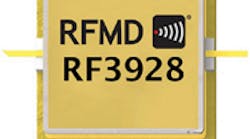The use of gallium nitride (GaN) heterojunction bipolar transistors (HBTs) has allowed the development of fairly compact modules, such as the model BBM3K5KKO (SKU 1189) from Empower RF Systems. It measures a mere 7.4 x 3.6 x 1.06 in. but delivers 100 W minimum saturated output power and 125 W typical saturated output power from 500 to 2500 MHz. The output power at 1-dB compression is 50 W over that frequency range, with 50-dB minimum gain.
The model BME19258-250 GaN power amplifier module from Comtech PST produces 280 W saturated output power and 250 W output power at 1-dB compression from 1000 to 2500 MHz, but measures 15.0 x 9.0 x 2.25 in. and weighs 14.5 lbs. Meanwhile, the model TGA2572 carrier-mounted GaN amplifier module from TriQuint Semiconductor measures only 3.5 x 5.9 x 0.1 mm but can provide 20 W output power from 14 to 16 GHz with 23-dB gain and 30% power-added efficiency.
Also of note is model RF3928 from RF Micro Devices. It measures just 16.7 x 17.4 x 2.4 mm in a hermetic flanged ceramic package (see figure), yet supplies 280 W pulsed output power from 2.8 to 3.4 GHz for S-band applications. It features 12-dB gain with 52% drain efficiency, drawing 440 mA from a +50-VDC supply when driving 100-s pulses at 10% duty cycle.
SSPAs from CAP Wireless feature the firm's unique Spatium spatial-combining techniques to sum the power contributions of multiple transistors with minimal combining losses. For example, the model CHPA0220-2-G45 Spatium power amplifier boasts broadband performance from 2 to 20 GHz with 15 typical saturated output power and 12 dB typical output power at 1-dB compression. The amplifier operates with 15% efficiency from a 10-A, +10-VDC supply with 48-dB typical gain and measures 17.08 x 9.93 x 5.81 in.
Although SSPA supporters point to the small size of their amplifiers, TWT-based amplifiers can also be made small enough for tower-mounting applications, such as the MT4500 series of multi-band TWTAs from MITEQ company MCL. The company amplifiers, which are available in bands from 5 to 51 GHz, offer as much as 400 W CW output power at X-band (7.9 to 8.4 GHz) frequencies in a housing measuring 14.2 x 16.4 x 31.0 in. MITEQ, like AR Worldwide, is technically "agnostic" when using solid-state and vacuum tubes, applying either technology to the best advantage. MITEQ is also among a handful of companies that excels in both power and LNAs, with a considerable number of amplifiers with noise figures of 0.5 dB or less. The model AMF-5F-02200230-04-13P LNA exhibits a noise figure of 0.4 dB from 2200 to 2300 MHz, with a gain of 68 dB and gain flatness of 0.5 dB across its 100-MHz bandwidth.
A number of companies offer surface-mount amplifiers that can be dropped onto a printed-circuit board (PCB), adding low-noise amplification where needed. Model TAMP-960LN+ from Mini-Circuits is an LNA designed for cellular communications applications from 824 to 960 MHz, with 0.55-dB typical noise figure in a package that is only 0.591 x 0.394 x 0.118 in. and draws only 40 mA current from a +5-VDC supply. And model MAAL-010705 from M/A-COM Technology Solutions is an LNA supplied in a 2 x 2 mm, 8-lead PDFN surface-mount package that generates 21-dB typical gain and 0.5-dB noise figure from 0.5 to 1.6 GHz while operating from a single +3-VDC (60 mA) supply.
